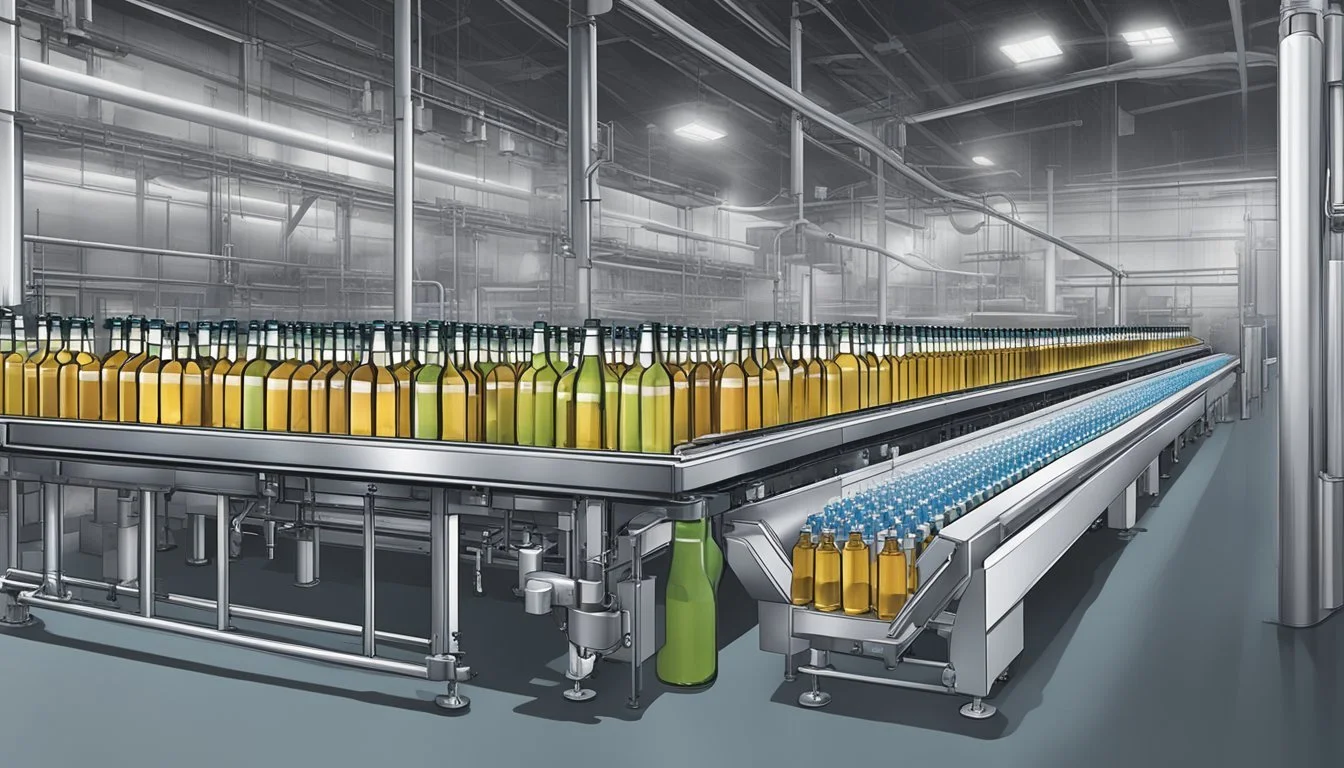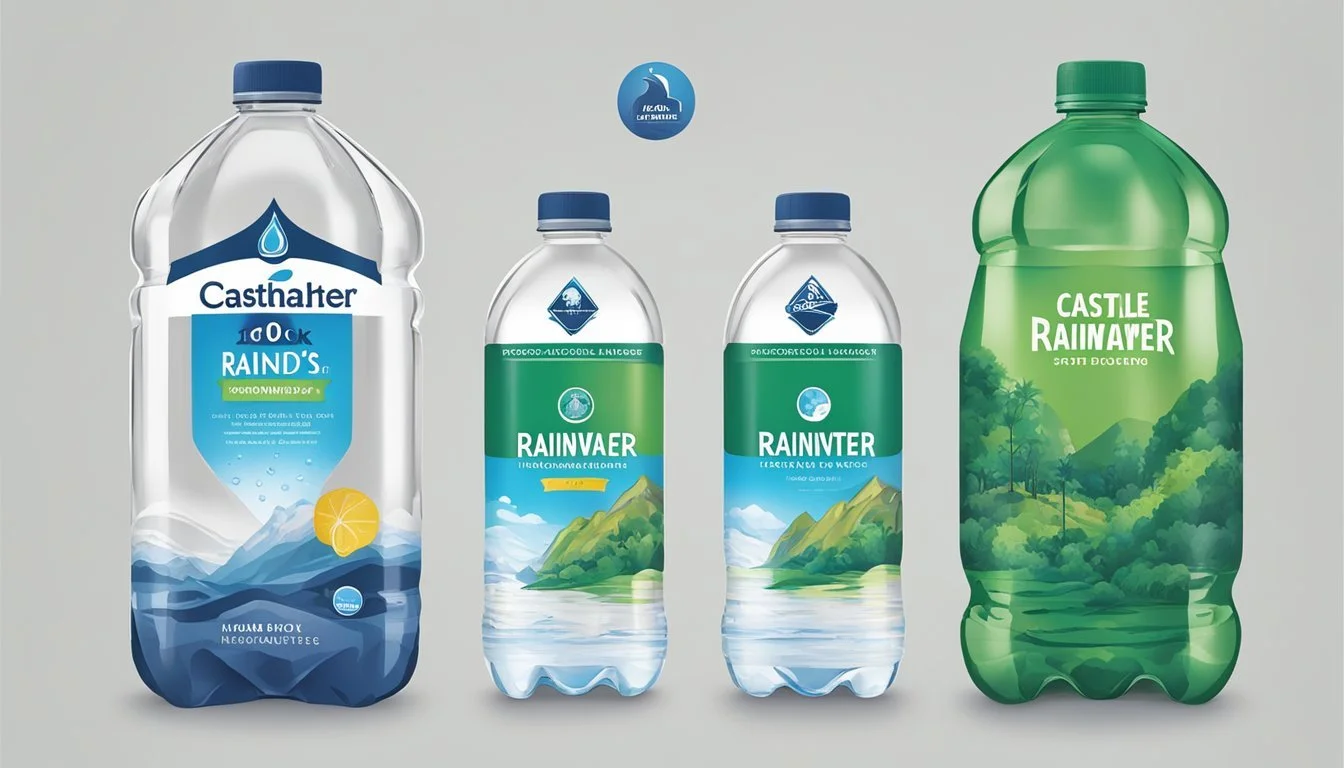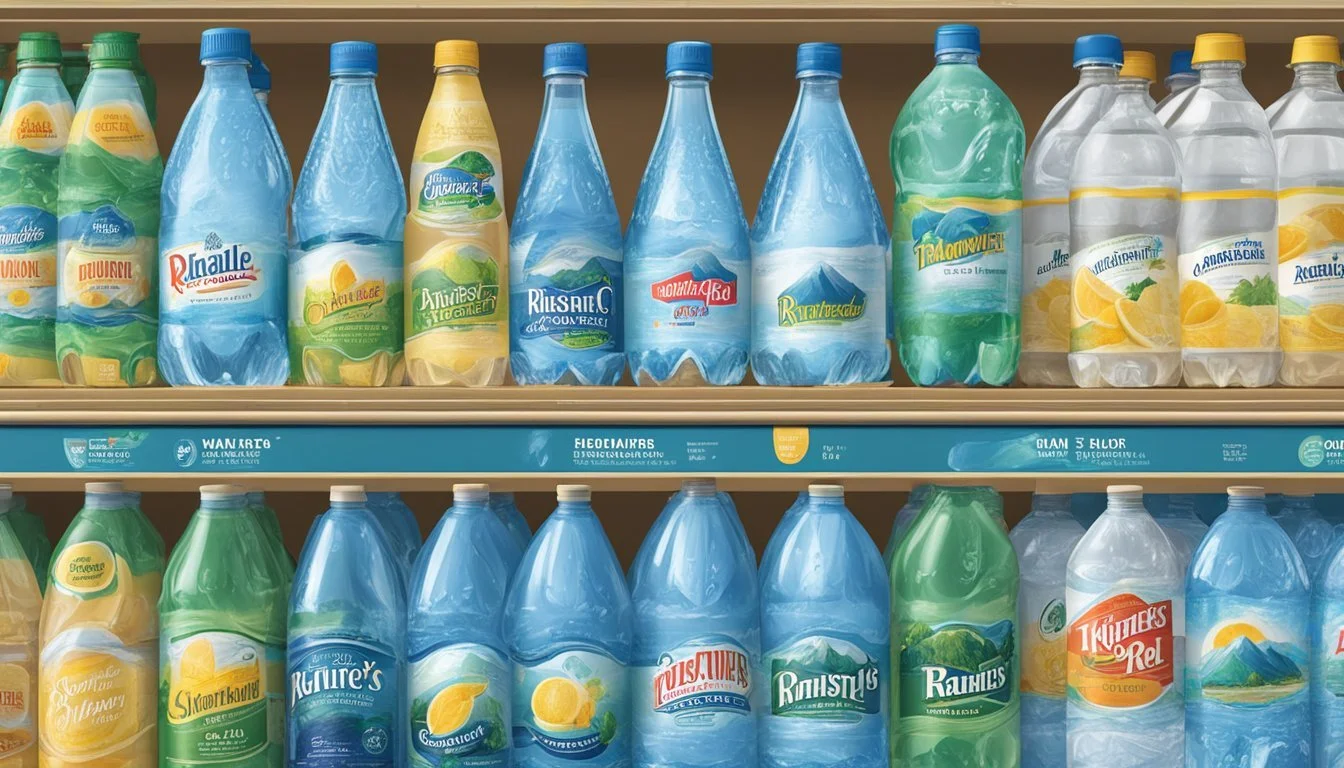Castle Rock vs. Richard’s Rainwater
Best Bottled Water Comparison
When it comes to choosing the right bottled water, two names often stand out: Castle Rock and Richard’s Rainwater. Both brands offer unique qualities that set them apart in the crowded market of drinking water. Castle Rock is celebrated for its crisp flavor, reminiscent of a refreshing morning hike in the mountains, making it a top choice for those who value a pristine, natural taste.
Richard’s Rainwater offers a distinct alternative by harvesting and bottling rainwater. This method not only provides a sustainable source of hydration but also distinguishes itself through its environmental consciousness. For those prioritizing sustainability and innovative water collection methods, Richard’s Rainwater is a standout option.
Both brands cater to different preferences and priorities, whether it's the taste of spring water from Castle Rock or the eco-friendly approach of Richard’s Rainwater. This comparison will help guide consumers in making an informed decision based on their specific needs and values.
Evolution of Bottled Water
The development of bottled water has a rich history, marked by technological advancements, shifting consumer preferences, and emerging environmental concerns. Each stage of its evolution has responded to different societal needs and environmental conditions.
Historical Context of Bottled Water
In the late 1970s, the advent of affordable PET (polyethylene terephthalate) bottles transformed the bottled water industry. This new packaging material democratized water bottling, making it accessible to a wider audience.
Small start-up companies started to thrive, leveraging the affordability of PET bottles to reach more consumers. Over time, the bottled water market expanded significantly. Today, more than 500 billion plastic water bottles are produced annually, a testament to the lasting impact of this packaging revolution.
Rise of Rainwater Collection
Recently, there has been a rising interest in capturing and bottling rainwater. Companies like Richard's Rainwater have pioneered this niche, focusing on harvesting potable rainwater directly from the clouds before it hits the ground and absorbs contaminants.
This method ensures a purer product without the need for chemical treatments. With increasing concerns over groundwater depletion and aquifer stress, rainwater collection is gaining traction as a sustainable and eco-friendly option.
Trends in Water Consumption
Consumer preferences for bottled water have evolved over the years. There is growing demand for products perceived as natural and eco-friendly. This trend is evident in the success of brands like Richard's Rainwater, which emphasizes its collection methods and purity.
Additionally, bottled water consumption has surged in response to growing concerns about water shortages and the quality of municipal water supplies. As more consumers seek alternatives to tap water, the market for various types of bottled water, including spring, mineral, and rainwater, continues to expand.
Brand Profiles
Castle Rock and Richard's Rainwater offer distinct aspects that highlight their dedication to providing quality bottled water. Through their unique backgrounds, each brand presents a different narrative in the bottled water market.
Castle Rock's Path to Purity
Castle Rock focuses on sourcing pure spring water from pristine environments. Their water is known for its crisp flavor, reminiscent of a morning hike in the mountains. Castle Rock maintains a high standard in its bottling practices to ensure that the natural taste and overall purity of the spring water are preserved. This brand emphasizes sustainability and environmental consciousness, often using recyclable materials and eco-friendly practices in their production process.
Castle Rock’s dedication to purity is evident in their rigorous quality control measures, which include regular testing and maintaining a clean extraction process. By prioritizing the preservation of natural resources, Castle Rock resonates with consumers who value both high-quality water and the sustainability of sourcing practices.
The Richard Heinichen Legacy
Richard's Rainwater stands out with a unique approach, utilizing harvested rainwater as its primary source. Founded by Richard Heinichen, the brand reflects his commitment to innovative water solutions. The process involves collecting rainwater, a practice Heinichen pioneered to ensure that the water remains free from contaminants common in other sources.
With an emphasis on purity, Richard's Rainwater undergoes extensive filtration steps, ensuring it is 100% potable and of high quality for consumption. Heinichen's vision of leveraging rainwater for commercial use demonstrates an inventive approach to addressing water scarcity issues.
Richard's Rainwater branding emphasizes its natural, clean source and commitment to quality, appealing to eco-conscious consumers. The minimal processing involved in collecting and filtering rainwater ensures a fresh and unique flavor, distinguishing it from traditional bottled waters.
Sourcing Methods
When comparing Castle Rock and Richard’s Rainwater, the methods they use to source their water are distinct and worth understanding in detail. Their approaches highlight differences in sustainability and water collection techniques.
Natural Springs vs. Rainwater Harvesting
Castle Rock sources its water from natural springs, predominantly located in Oregon. The water is collected at these springs, known for their pristine, mineral-rich profiles. This method capitalizes on underground aquifers that naturally filter impurities over time, resulting in high-quality spring water.
Richard’s Rainwater, on the other hand, uses rainwater harvesting techniques. The rainwater is collected directly from rooftops and other surfaces and then undergoes purification. This approach allows Richard’s Rainwater to capture fresh water from rainfall before it reaches the ground, avoiding potential contamination.
Sustainable Sources and Collection Techniques
Castle Rock prioritizes sustainable practices by ensuring that the natural springs are protected from over-extraction, aligning with environmental standards. These springs are monitored to maintain ecological balance, providing a continuous, renewable water source.
Richard’s Rainwater focuses on rainwater collection, emphasizing sustainability. The company collects rainwater in large tanks, known as Tank Town, before purification and packaging. This method reduces the strain on local water resources and promotes the efficient use of naturally occurring rain, making it a more sustainable option.
Both companies are deeply invested in sustainable water collection, each using methods that reflect their commitment to environmental responsibility.
Manufacturing Processes
Castle Rock and Richard’s Rainwater employ different yet effective methods to ensure their water is pure and meets high standards. Both brands emphasize filtration, purification, and strict quality control measures.
Filtration and Purification
Castle Rock sources its water from natural springs, focusing on preserving the water's original purity. Their process includes multi-stage filtration to remove any potential contaminants without altering the water's natural mineral balance. This includes sand filtration, carbon filtration, and UV treatment to ensure biological safety and clarity.
Richard’s Rainwater, on the other hand, collects rainwater and uses a proprietary zero-waste, chlorine-free filtration system. This system removes biological and particulate contaminants through multiple processes such as micron filtration and UV light, ensuring the water is safe for consumption. By eliminating chlorine, Richard’s Rainwater aims to provide a more natural taste without chemical residues.
Quality Control and Water Standards
Quality control is paramount for both Castle Rock and Richard’s Rainwater to maintain high water standards. Castle Rock adheres to strict industry regulations, conducting regular laboratory testing to monitor mineral content and potential contaminants. Each batch is sampled and analyzed to ensure it meets FDA and state guidelines.
Richard’s Rainwater follows rigorous testing protocols to maintain purity. They undertake continuous on-site testing to verify the absence of biological, particulate, and chemical contaminants. Their systems are designed to comply with EPA standards, and every batch of water is tested for quality before bottling. The use of advanced filtration ensures that the water is not only potable but also pristine and environmentally friendly.
Packaging and Environmental Impact
This discussion contrasts the packaging methods employed by Castle Rock and Richard’s Rainwater, focusing on their impact on the environment and the materials used. Understanding these aspects helps determine which brand better aligns with eco-friendly practices.
Bottle Design: Glass vs. Plastic vs. Cans
Castle Rock primarily uses glass bottles. Glass is favored for its ability to preserve taste and is fully recyclable. It is an inert material, meaning it does not leach chemicals into the water.
Richard’s Rainwater uses recyclable aluminum cans and some plastic bottles. Aluminum cans are lightweight and have a lower carbon footprint during transportation compared to glass. They are highly recyclable, with a significant portion of them being repurposed repeatedly.
Plastic bottles, though used less by Richard’s Rainwater, pose a higher environmental burden. They contribute significantly to pollution due to their low recycling rate. Reusable plastic options may mitigate this, but single-use plastics remain a concern.
Climate Conscious Packaging Solutions
Richard’s Rainwater has integrated a virtually zero-waste filtration system, making their water collection and packaging process exceptionally eco-efficient. By utilizing rainwater, they reduce the dependency on conventional water sources and enhance water availability. This initiative helps in reducing the overall environmental footprint.
Castle Rock’s use of glass bottles aligns with sustainable practices. However, the higher transportation emissions due to the weight of glass could offset some environmental benefits. Their commitment to recycling practices remains crucial to their environmental impact.
Both brands show a commitment to reducing their environmental footprint, with Richard's Rainwater emphasizing innovative approaches while Castle Rock sticks to traditional, recyclable materials.
Flavor Profile and Water Quality
Castle Rock and Richard’s Rainwater offer distinctive flavor profiles and water quality characteristics, informed by their unique sources and mineral compositions.
Mineral Content and Taste Distinctions
Castle Rock water, originating from Shasta Springs, is known for its crisp and refreshing taste. This spring water contains naturally occurring minerals that add subtle flavor notes, reminiscent of a morning hike in the mountains. On the other hand, Richard's Rainwater, harvested as rainwater, offers a cleaner and more neutral taste with minimal mineral content, emphasizing purity.
While Castle Rock has a mild mineral aftertaste, it also brings a sense of freshness accentuated by light carbonation in some variants. Richard's Rainwater stands out for its absolute clarity and absence of any detectable aftertaste, ensuring a straightforward drinking experience.
Water Properties and Drinking Experience
Castle Rock provides a versatile drinking experience. Its slightly carbonated version enhances the refreshing sensation, making it a popular choice for those who prefer a bit of fizz. The water's quality and taste remain consistent, offering a reliable hydration option. Additionally, Castle Rock's emphasis on using 55% recycled glass for bottles reflects its commitment to sustainability.
Richard's Rainwater prioritizes clean water by filtering rainwater to ensure it is 100% potable. This method results in water that is exceptionally pure. Consumers who prioritize the absence of additives and a neutral taste prefer Richard’s Rainwater for its simplicity and directness. The absence of minerals and any additional carbonation highlights its natural essence.
Market Presence and Distribution Networks
Castle Rock and Richard’s Rainwater have distinctly different market presences and distribution networks, reflecting their unique approaches to the bottled water industry. Both brands have made strides in retail expansion and online availability, with partnerships that boost their accessibility to consumers.
Retail Expansion and Accessibility
Castle Rock's distribution primarily leverages traditional retail routes, with a noticeable presence in regional and national chains. Whole Foods Market and Sprouts are essential partners, helping Castle Rock achieve significant shelf space. Their regional focus provides a robust foothold in high-traffic locations, ensuring their product reaches health-conscious consumers.
Richard’s Rainwater, on the other hand, has aggressively expanded its retail presence. Their distribution at Sprouts and Whole Foods Market is complemented by availability at Central Market and select HEB locations. This broad reach, combined with a unique product offering, enhances the brand's visibility. The brand's growth is evident, with sales projected to exceed $10 million, reflecting successful retail strategies.
Online Availability and Retailer Relationships
Castle Rock maintains an online presence through platforms like Amazon, allowing for nationwide availability. Their strong partnership with major e-commerce outlets ensures they can reach customers outside their physical retail footprint. This e-commerce strategy captures a tech-savvy audience who prefers online shopping.
Richard’s Rainwater has also capitalized on online retail opportunities. They are available on Amazon and other online retailers, facilitating wide-reaching access. Their partnerships have translated to efficient distribution networks, bolstering both regional and national sales. These relationships ensure that consumers can purchase their products easily, whether in-store or online.
Both brands have established strong market presence and distribution networks, vital to their continued growth and customer reach.
Brand Influence and Community Engagement
Castle Rock and Richard’s Rainwater both emphasize their community involvement and digital presence. While Castle Rock focuses on partnerships and local engagement, Richard’s Rainwater leans into sustainability and reaching broader audiences online.
Outreach and Community Projects
Castle Rock partners with various local organizations to support environmental causes and community events. They have collaborated with entities like Lazy Magnolia and Faubourg Brewing Co to promote sustainability. These partnerships help to reinforce their commitment to the environment and community welfare.
Richard’s Rainwater stands out for its unique approach to community engagement by donating water to areas in need. They have a strong presence in community projects, ensuring clean drinking water is accessible where it's most needed. This community-driven approach helps them build a loyal customer base.
Social Media and Digital Presence
Castle Rock maintains an active presence on Instagram, Twitter, and LinkedIn. They use these platforms to share updates about their sustainability projects, product launches, and partnership announcements. Their social media strategy often includes user-generated content, engaging directly with customers.
Richard’s Rainwater leverages social media to highlight their sustainability efforts and community initiatives. They are active on platforms like Instagram and Twitter, frequently posting about their water donation projects and environmental impact. By showcasing these efforts online, they foster a connection with environmentally-conscious consumers.
The Future of Rainwater and Spring Water
The future of drinking water lies in innovative solutions and sustainable practices to ensure access to safe and renewable water. This section explores key advancements in rainwater and spring water technologies and the drive toward a net-positive water impact.
Innovative Water Solutions
Innovation in water solutions is crucial. Richard’s Rainwater, a prominent player, captures rainwater using America's first rain capture facility in Louisiana. This method transforms raindrops into a potable and environmentally-friendly water source.
Rainwater harvesting offers a renewable alternative and reduces pressure on conventional water sources. Cities like New York, among the top three rainiest cities in the US, present significant potential for rainwater collection. Spring waters, such as Castle Rock, benefit from advanced filtration technologies preserving natural minerals while ensuring purity and safety.
Building Toward a Net-Positive Water Impact
Sustainability is vital. Both Castle Rock and Richard’s Rainwater are working towards a net-positive water impact, which means contributing more to the environment than they consume. Richard’s Rainwater emphasizes minimal carbon footprint and the use of recyclable materials in packaging.
Castle Rock focuses on preserving natural springs, ensuring that surrounding ecosystems remain undisturbed. Addressing water issues like scarcity and pollution, these brands aim to create solutions that enhance water access and quality for all. Using innovative approaches, their commitment to renewable water resources positions them as leaders in the movement towards sustainable hydration.








